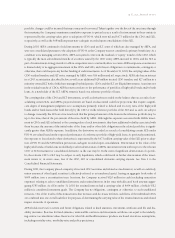American Express 2003 Annual Report Download - page 75
Download and view the complete annual report
Please find page 75 of the 2003 American Express annual report below. You can navigate through the pages in the report by either clicking on the pages listed below, or by using the keyword search tool below to find specific information within the annual report.
expressions are intended to identify forward-looking statements. Readers are cautioned not to place undue reliance on these
forward-looking statements, which speak only as of the date on which they are made. The Company undertakes no
obligation to update or revise any forward-looking statements. Factors that could cause actual results to differ materially
from these forward-looking statements include, but are not limited to: the Company’s ability to successfully implement a
business model that allows for significant earnings growth based on revenue growth that is lower than historical levels,
including the ability to improve its operating expense to revenue ratio both in the short-term and over time, which will
depend in part on the effectiveness of reengineering and other cost-control initiatives, as well as factors impacting the Com-
pany’s revenues; the Company’s ability to moderate the growth rate of its marketing, promotion, rewards and cardmember
services expenses to levels below 2003; the Company’s ability to accurately estimate the provision for the cost of the
Membership Rewards program; the Company’s ability to grow its business and meet or exceed its return on shareholders’
equity target by reinvesting approximately 35% of annually-generated capital, and returning approximately 65% of such
capital to shareholders, over time, which will depend on the Company’s ability to manage its capital needs and the effect of
business mix, acquisitions and rating agency requirements; the ability of the Company to generate sufficient revenues for
expanded investment spending and to actually spend such funds to the extent available, and the ability to capitalize on such
investments to improve business metrics; credit risk related to consumer debt, business loans, merchant bankruptcies and
other credit exposures both in the U.S. and internationally; fluctuation in the equity and fixed income markets, which can
affect the amount and types of investment products sold by AEFA, the market value of its managed assets, and manage-
ment, distribution and other fees received based on the value of those assets; AEFA’s ability to recover DAC, as well as the
timing of such DAC amortization, in connection with the sale of annuity, insurance and certain mutual fund products;
changes in assumptions relating to DAC, which could impact the amount of DAC amortization; the ability to improve invest-
ment performance in AEFA’s businesses, including attracting and retaining high-quality personnel; the success, timeliness
and financial impact, including costs, cost savings and other benefits including increased revenues, of reengineering initia-
tives being implemented or considered by the Company, including cost management, structural and strategic measures such
as vendor, process, facilities and operations consolidation, outsourcing (including, among others, technologies operations),
relocating certain functions to lower-cost overseas locations, moving internal and external functions to the Internet to save
costs, and planned staff reductions relating to certain of such reengineering actions; the ability to control and manage oper-
ating, infrastructure, advertising and promotion and other expenses as business expands or changes, including balancing
the need for longer-term investment spending; the potential negative effect on the Company’s businesses and infrastruc-
ture, including information technology, of terrorist attacks, disasters or other catastrophic events in the future; the impact
on the Company’s businesses resulting from continuing geopolitical uncertainty; the overall level of consumer confidence;
consumer and business spending on the Company’s travel related services products, particularly credit and charge cards
and growth in card lending balances, which depend in part on the ability to issue new and enhanced card products and
increase revenues from such products, attract new cardholders, capture a greater share of existing cardholders’ spending,
sustain premium discount rates, increase merchant coverage, retain cardmembers after low introductory lending rates have
expired, and expand the global network services business; the triggering of obligations to make payments to certain co-
brand partners, merchants, vendors and customers under contractual arrangements with such parties under certain cir-
cumstances; successfully cross-selling financial, travel, card and other products and services to the Company’s customer
base, both in the United States and internationally; a downturn in the Company’s businesses and/or negative changes in the
Company’s and its subsidiaries’ credit ratings, which could result in contingent payments under contracts, decreased liq-
uidity and higher borrowing costs; fluctuations in interest rates, which impact the Company’s borrowing costs, return on
lending products and spreads in the investment and insurance businesses; credit trends and the rate of bankruptcies, which
can affect spending on card products, debt payments by individual and corporate customers and businesses that accept the
Company’s card products and returns on the Company’s investment portfolios; fluctuations in foreign currency exchange
rates; political or economic instability in certain regions or countries, which could affect lending and other commercial
activities, among other businesses, or restrictions on convertibility of certain currencies; changes in laws or government reg-
ulations; the costs and integration of acquisitions; and outcomes and costs associated with litigation and compliance with
regulatory matters. A further description of these and other risks and uncertainties can be found in the Company’s Annual
Report on Form 10-K and its other reports filed with the SEC.
(p.73_axp_ financial review)
























